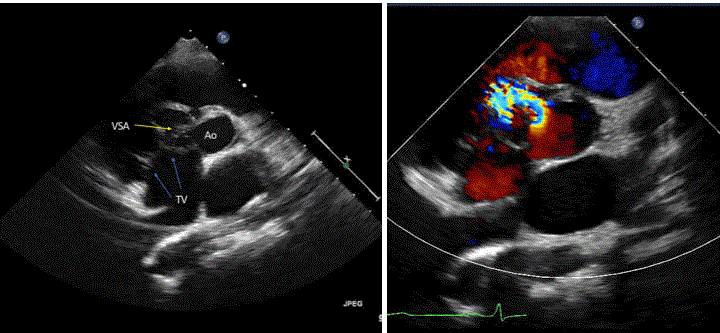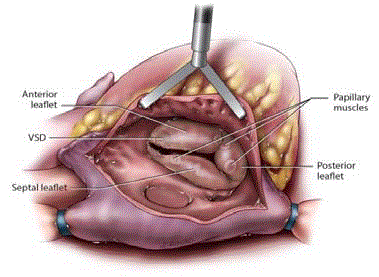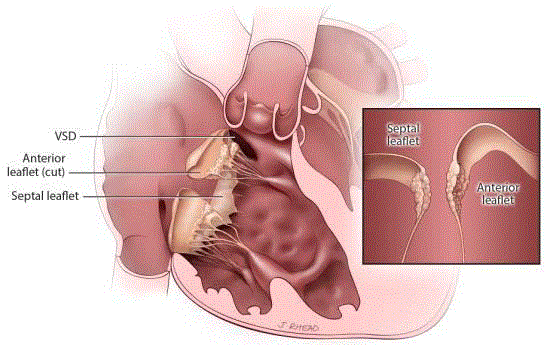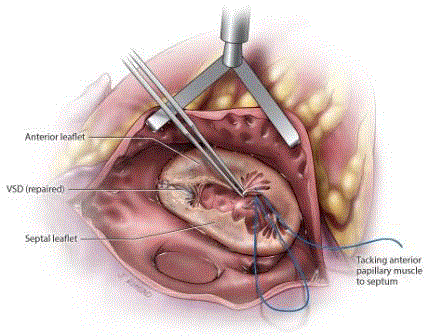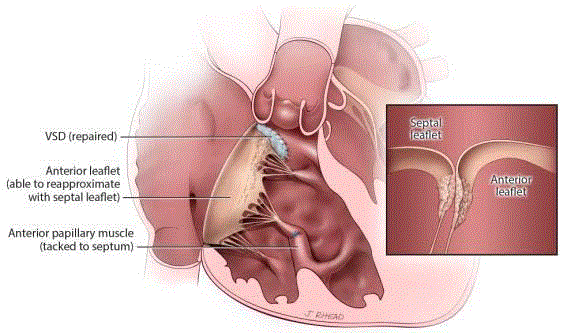Surgical Technique
A Reproducible Technique to Repair Tricuspid Valve Dysfunction Associated with a Chronic Ventricular Septal Defect
Aaron W. Eckhauser* and Phillip T. Burch
Department of Cardiothoracic Surgery, University of Utah and Primary Children’s Hospital, USA
*Corresponding author: Aaron W. Eckhauser, Department of Surgery, Division of Cardiothoracic Surgery, Section of Pediatric Cardiothoracic Surgery, University of Utah and Primary Children’s Hospital, 100 N. Suite 2200, Salt Lake City, UT 84113, USA
Published: 25 May, 2017
Cite this article as: Eckhauser AW, Burch PT. A
Reproducible Technique to Repair
Tricuspid Valve Dysfunction Associated
with a Chronic Ventricular Septal
Defect. Clin Surg. 2017; 2: 1485.
Abstract
A small subset of patients with ventricular septal defects (VSD) is noted on echocardiography to have
partially occlusive ventricular septal aneurysmal (VSA) tissue. These patients are often managed
medically in anticipation of spontaneous closure. However, we have found that rather than being
indicative of spontaneous closures this echocardiographic aneurysmal tissue can be misinterpreted,
and represents a specific pattern of damage to the tricuspid valve. If echocardiographic VSA develops
in the setting of a perimembranous VSD, contrary to historical practice, we feel that consideration
should be given to earlier operation to limit progressive valve injury. Various techniques are
available to surgically address tricuspid valve dysfunction during repair of a VSD, but we present
a simple and reproducible technique to reliably repair the valve in this unique subset of patients.
Keywords: Congenital heart disease, CHD; CHD, Septal defects; CHD; Valve; Heart valve
repair; Tricuspid valve
Introduction
At our institution we have encountered an infrequent, but significant clinical problem in some patients with ventricular septal defects (VSD). The majority of our patients with a VSD present early (3-6 months of age) for repair with clear indications for surgery. However, small subsets of these patients are noted on echocardiography to have ventricular septal aneurysmal (VSA) tissue that is partially occluding the VSD (Figure 1). Patients that develop restrictive VSA tissue are often managed medically in anticipation of spontaneous closure. We have recently operated on 4 consecutive patients at our institution for a VSD whose referral to surgery was delayed because they were thought to have partially occlusive VSA tissue on echocardiogram. At the time of surgery it was noted that none of these patients actually had VSA tissue. The “VSA” tissue seen on echo actually represented a much thickened septal leaflet of the tricuspid valve that was prolapsing into the VSD. Each of these patients developed a consistent pattern of damage to the tricuspid valve. The purpose of this case report is [1] to highlight the pathological changes that can occur to the tricuspid valve and be misinterpreted as VSA, and [2] present a reproducible surgical technique to address significant tricuspid valve damage in this subset of patients.
Surgical Technique
Exposure was performed through a median sternotomy and cardiopulmonary bypass was
established with central aortic cannulation and bicaval venous cannulation. Cardiac arrest was
achieved with antegrade cardioplegia and the left heart was vented through the right superior
pulmonary vein.
VSD inspection and closure
The VSD was approached through a standard right atriotomy with retraction of the septal and
anterior leaflets of the tricuspid valve. As mentioned above, no VSA tissue was identified in any
patient. Close inspection revealed that the anterior portion of the septal leaflet would easily prolapse
down into the VSD unless manually withdrawn. Each VSD was located in the perimembranous
region and standard closure was achieved with a Dacron patch.
Inspection of the tricuspid valve
After closure of the VSD, the right ventricle was injected with saline to test the competency of
the tricuspid valve. On static testing, all 4 patients had tricuspid incompetence with prolapse of the anterior leaflet. Inspection of the valve revealed several consistent findings [1]; blunting of the commissure between the anterior and
septal leaflet, significant thickening of the anterior and septal leaflet in
the area of the commissure, significant attenuation and lengthening
of the chordal and papillary muscle support to the anterior leaflet
(Figure 2A,B). Using a blunt nerve hook, the free edge of the anterior
leaflet could easily be elevated above the plane of the annulus.
Tricuspid valve repair
The same technique was used to repair all 4 tricuspid valves. The
valvar disease was repaired by placing two horizontal mattress 5-0
polypropylene sutures in the anteroseptal commissure to recreate a
sharp commissural angle and provide some support to both leaflets.
The subvalvar disease was addressed at the papillary level by suturing
the head of the anterior papillary muscle to the ventricular septum
(Figures 3,4). The papillary muscle was translocated to the ventricular
septal in the mid-portion of the septal leaflet area. The height of
the translocation site was identified by using a blunt nerve hook to
establish an appropriate height of the anterior leaflet in relation to
the annular plane and still maintaining an adequate coaptation area.
Once this was identified, the attenuated papillary muscle supporting
the anterior leaflet was sutured to the ventricular septum using a single
pledgeted 5-0 polypropylene suture in a horizontal mattress fashion.
Typically, the papillary muscles are very mobile, but occasionally the
base may need to be mobilized towards the apex to achieve a tension
free repair.
Figure 1
Figure 1
Echocardiographic image of VSA in parasternal short axis. Ao:
Aorta; TV: Tricuspid Valve Leaflets; VSA: Ventricular Septal Aneurysm.
Figure 2A
Figure 2B
Figure 3
Figure 4
Results
The first patient in the series had mild-to-moderate tricuspid regurgitation (TR) preoperatively. Initially, I only attempted a VSD closure but the intraoperative transesophageal echo showed severe TR with significant prolapse of the anterior leaflet. I returned to bypass and performed the above stated repair with a subsequent intraoperative echo showing trivial TR and no stenosis. The followup echo at 1 year showed a thickened tricuspid valve with mild prolapse of the anterior leaflet with trivial TR and no stenosis. The second patient preoperatively had mild TR with an intraoperative echo showing trivial TR and no stenosis. This patient has not followed up within our system. The third patient had moderate-to-severe TR preoperatively and the intraoperative echo showed trivial TR with no stenosis. One-year follow-up echo showed a thickened tricuspid valve with trivial TR and no stenosis. The fourth patient had mild TR preoperatively. The intraoperative echo showed no TR and no stenosis. Eight-month follow-up showed a thickened tricuspid valve with trivial TR and no stenosis.
Discussion
We report 4 consecutive patients who developed significant
damage to the tricuspid valve apparatus while being followed for
a VSD that was thought to be restricted by aneurysmal tissue.
The assumption in each case was that the VSA was aneurysmal
transformation of membranous septal tissue around the perimeter of the VSD, and that it might facilitate spontaneous closure. However,
no true aneurysmal tissue was identified at the time of surgery in any
of these cases. The VSA described on echo was actually the anterior
portion of the septal leaflet of the tricuspid valve prolapsing into the
VSD and causing restriction.
Interestingly, the damage to the tricuspid valve in each scenario
was similar; the anterior portion of the septal leaflet and septal
portion of the anterior leaflet were both extremely thickened with
aneurysmal enlargement of the anterior leaflet. Furthermore, the
anterior papillary muscle was significantly attenuated and the chordae
were elongated. Intraoperatively, in each case after VSD closure, the
combination of these defects caused prolapse of the anterior leaflet
producing valvar incompetence on static testing. All 4 valves were
repaired in a similar fashion, with antero-septal commissuroplasty
and translocation of the papillary muscle of the anterior leaflet to the
ventricular septum. The translocation technique is very similar to
the modified Sebening stitch used in the repair of Ebsteins anomaly
[1]. Interestingly, each patient had a very similar pattern of injury
upon surgical inspection that was not obvious on preoperative
imaging. Only 1 patient had more than mild-moderate tricuspid
valve regurgitation on preoperative imaging. All 4 patients left the
operating room with trivial tricuspid valve regurgitation.
Injury to the tricuspid valve after VSD closure is a known
complication and the mechanisms include direct damage to the valve,
tethering or injury to the chordal support and annular distortion
caused by either under- or over-sizing the patch. In these scenarios,
the tricuspid leaflets are relatively normal, and the injury is surgically
induced. However, in our subgroup of patients, the presence of
echocardiographic VSA was really a manifestation of significant
damage to the tricuspid valve that remained clinically silent. Our
theory, in three of the four cases, as to why there wasn’t more
preoperative tricuspid regurgitation is that the elongated portion of
the anterior leaflet filled the void left by the septal leaflet prolapsing
into the VSD. Certainly, not all VSDs with echocardiographic
evidence of VSA will develop tricuspid dysfunction as described.
However, we feel that the development or identification of VSA in
a patient with a perimembranous VSD should be interpreted with
caution. Rather than being a reassuring sign of spontaneous closure
it may represent a pathologic adaptation of the tricuspid valve in
which true tricuspid leaflet tissue causes partial VSD occlusion with
resultant valve damage. If echocardiographic VSA develops in the
setting of a perimembranous VSD then consideration should be
given to earlier operation to limit progressive valve injury but in cases
where the valve is already damaged this is a simple and reproducible
technique to reliably repair the valve.
Acknowledgment
We would like to acknowledge Jill Rhead MA, CMI, FAMI for all the original illustrations. Jill Rhead works at Intermountain Medical Center located at5121 S. Cottonwood St, Eccles Outpatient Care Center, Suite 309, Murray, UT, 84107.

